Signs of Dugongs Surviving in Okinawa Island's Waters!: New Dugong Feeding Trails Found near Kouri Island
On April 7, 2021, the Japanese Ministry of the Environment released its annual report on the status of the dugong and its conservation efforts in the waters of Okinawa. The report has raised hope for the survival of dugongs in the waters of Okinawa Island, the largest and most populated island of the prefecture. It has also underscored the need to enhance civil society's efforts to protect the endangered Okinawa dugong.
The ministry's report informs that dugong feeding trails were found near Kouri Island, northern Okinawa Island, during the ministry's survey in June 2020. (No dugong trails were observed during its most recent survey in January 2021 survey). The report also describes that dugong feeding trails were observed in the Yaeyama and Miyako areas, confirming the ministry's previous reports on the status of dugongs in these areas.
 |
| Dugong feeding trails found near Kouri Island in June 2020 Image Source: Ministry of the Environment (2021) |
 |
| Red circles indicate the environment ministry's monitoring areas, Kouri Island, Sumuide, and Kayo: the top circle is the Kouri Island area. Image Source: Ministry of the Environment (2021) |
The environment ministry's efforts to monitor dugongs in the waters of Okinawa have been upgraded in the last year. Environmental DNA testing, drone survey, and sound monitoring are now part of the ministry's survey efforts, and the upgrading is in line with the recommendations made by IUCN's Dugong Working Groups in December 2019.
The Fate of the Dugong in the Waters of Okinawa Island
The ministry's report was welcoming news, especially in light of the growing concern over the fate of dugongs in Okinawa Island's waters in relation to the construction of a U.S. military base in Henoko-Oura Bay on the east side of northern Okinawa Island. (See this article)
In its Environmental Impact Assessment process, the Ministry of Defense identified and began monitoring three individual dugongs in the waters of northern Okinawa Island. After the ministry began landfill work for base construction in August 2018, two of the dugongs, which had been sighted in Henoko-Oura Bay and its neighboring area Kayo, began changing their behaviors. Since December 2018, no dugongs have been sighted, and no feeding trials have been found in Henoko-Oura Bay and Kayo.
 |
| Dugong and seaturtle swiming together was a common sight in northern Okinawa Island until recently Image Source: Okinawa Defense Bureau (2014) |
Meanwile, in March 2019, a female dugong was found dead near Kouri Island on the west side of northern Okinawa Island. It was identified as one of the three dugongs, which was seen most frequently in the Kouri Island area. Since the death of this particular dugong, no dugongs were sighted and no dugong feeding trails in the Kouri Island area.
Thus, concerns were raised that no dugongs were surviving in the waters of Okinawa Island, and in December 2019, ICUN listed the dugong in Nansei region as critically endangered on its Red List.
Dugong Calls (?) near Base Construction Site
While no reports on dugong sightings and dugong feeding trails in Okinawa Island's waters were made in 2020, the Ministry of Defense recorded in the same year more than 200 times sounds of what its expert described as "possible dugong calls" near the construction site in Oura Bay. Most of these recordings were made when there were no construction activities.
These recordings raised hope that dugongs are still surviving in Okinawa Island's waters. They also prompted environment NGOs and politicians to call for a release of the recordings for eternal examination and a review of the impacts of base construction on the dugong.
However, the defense ministry refused to release the recordings to the public and later suggested that the sounds might have come from construction equipment like buoys and floats. As of today, the defense ministry has not released the recordings. By avoiding verifying whether they were of dugong calls (or whether dugongs were present in Oura Bay), the ministry has allowed itself to continue landfilling work.
Environment Ministry's Report and Civil Society
With the environment ministry's new report, the elusive Okinawa dugong is back in the spotlight. The report certainly encourages us environmental NGOs to figure out how we could utilize the information to protect the dugongs in Okinawa Island's waters.
In the previous studies by both the environment and defense ministries, dugongs were observed to move between Henoko-Oura Bay and Kouri Island along the coast of northern Okinawa Island. Thus, it is logical to call for an examination of the relationship between the feeding trails found in Kour Island and the recordings of possible dugong calls in Oura Bay. After all, Okinawa Island is small, and the areas where dugongs can feed on seagrass are limited.
 |
| Movement of "Dugong C" between west and east coasts of Okinawa Island (2007 to 2013) Image Source: Okinawa Defense Bureau (2014) |
Indeed, the ministry's present report does not mention military base construction and Henoko-Oura Bay. Nor does it provide any discussion on why no dugong activities have been observed in the Kayo area for the last two years, even though the environment ministry has conducted surveys in Kayo as a critical dugong habitat for over 15 years.
As frustrating as this situation may be, this report is probably the best the environment ministry can do for the time being. In other words, environment NGOs and other civil society members need to make the best use of the report to challenge the defense ministry. So for our move, we will try to get the recordings of "possible dugong calls" released. Please join this "Be Part of a New Dugong Story" campaign!


